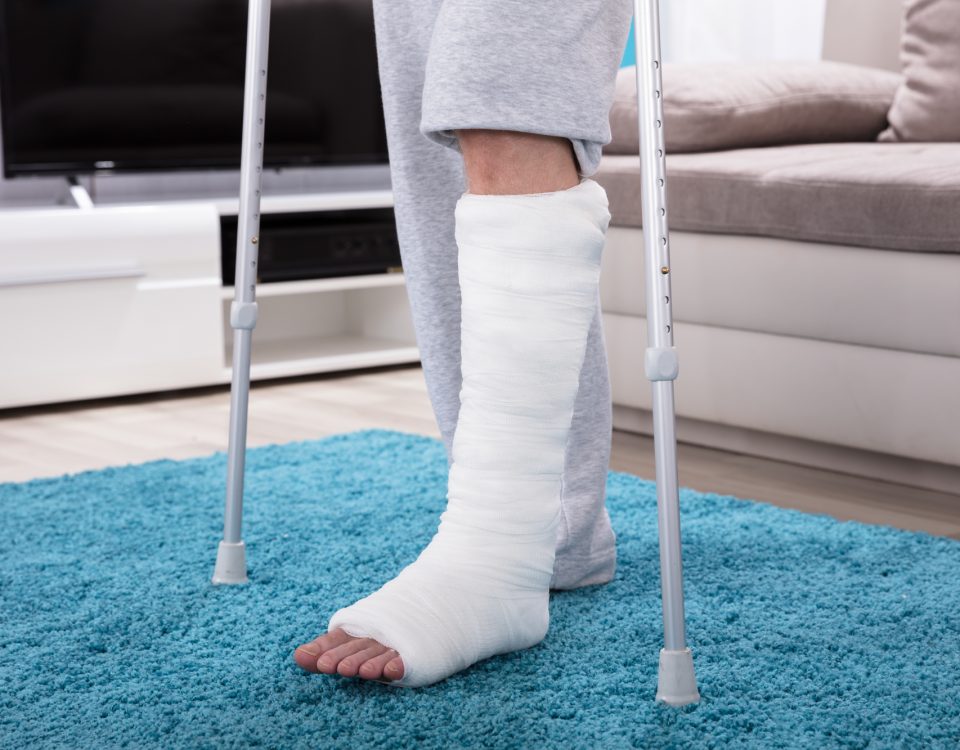When we hear about someone having a broken hip, we often think of the elderly. It’s true that while many of the over 200,000 cases of hip fractures that occur annually in the U.S. occur in patients over 60, the elderly are not the only ones who can suffer from this injury.
Having a broken hip can mean surgery and a long recovery, but it doesn’t have to mean the end of an active lifestyle. Read on to learn more about this injury and what is involved in the healing process.
What is a Hip Fracture?
Many people believe that a hip fracture is a break in the pelvis, but that’s not the case. A broken hip is a break in the femur, also known as the thighbone. The joint where the pelvis and the femur come together is a ball-and-socket joint, with the “ball” or head of the femur connecting to the “socket” or pelvis.
Generally, a hip fracture is a break right below the head of the femur, also known as a femoral neck fracture. A break a little further down on the bone is known as an intertrochanteric hip fracture. Both cause significant pain for the patient and can take a long time to heal.
Symptoms of a hip fracture can include:
- Not able to move after a fall
- Severe pain in hip or groin
- Not able to put weight on leg with broken femur
- Leg shortness on the side of injury
- Leg turning outward on the side of injury
A hip fracture is a severe injury that shouldn’t be ignored. If you think a loved one may have suffered a hip fracture, it’s time to get them to the emergency room as quickly and gently as possible.
Who is At Risk?
The most common group of people to experience hip fractures are those over the age of 65. As we age, many of us will develop osteoporosis, a condition that causes our bones to become more fragile. This condition, in turn, makes it easier for bones to break suddenly – in the case of a hip fracture, usually after a sideways fall. Senior women have a higher risk of experiencing a broken hip due to an increased risk for osteoporosis.
While senior citizens are by far the most likely group to experience this type of injury, younger people who are very active can also find themselves at risk for a hip fracture due to high impact collisions. Sports like snowboarding and bicycling are higher risk activities for this type of injury, due to an increased risk of falling sideways directly onto the hip joint. In these cases, it’s best to learn how to fall to reduce your risk of injury.
People with overactive thyroid issues and other endocrine disorders can sometimes have a problem with hip fractures. We do know that tobacco and alcohol use can put people at higher risk, due to their ability to contribute to bone weakness.
If you fall into a high-risk group for hip fractures, these prevention tips may be helpful:
- Remove anything from the home which could cause a fall – falling sideways is an exceptionally high-risk fall for a broken hip
- Add items that will help reduce your risk of falling – brighter lights, assistance bars, etc.
- Exercise regularly, including strength and balance training
- Be careful of medications – some drugs can cause bones to weaken
- Watch your diet – be sure to eat a healthy diet high in calcium and Vitamin D
- Maintain a healthy weight
- Get screened for osteoporosis
How is a Hip Fracture Treated?
Unless the patient is a very young child, hip fractures almost always require surgery to repair. First, the doctor will need to take a look at the break either using an X-ray, CT, or MRI scan, to determine exactly where the break is and how much damage has occurred in the area.
For those patients who need surgery, the decision to try and repair the femur or replace a portion of the hip joint is the next step. A few factors come into play here, including how old the patient is, how active they are, and the probability of the bone healing relatively quickly. If the surgeon decides that the bone is likely to be repaired, then screws will be used to hold everything together during the healing process.
If a bone is too severely damaged, or the patient is older with a history of osteoporosis, then it is likely that a hip replacement will be used to treat the injury. A replacement will provide a better chance of mobility after recovery from the initial surgery.
In some cases, a patient with a hip fracture is either too ill for surgery or is already suffering from mobility issues that prevent them from walking. In these cases, a doctor may opt not to perform surgery and treat the problem with comfort measures only, such as pain medicine to keep the patient comfortable.
How Long is the Healing Process?
A hip fracture is a serious injury and requires months of healing time and physical therapy for recovery. The exact amount of time needed to heal from a hip fracture varies – it all depends on how bad the break is and the condition of the patient when the break occurred. Younger patients in excellent condition will likely heal faster than elderly patients in poor health.
Either way, a more rapid recovery requires the patient to work hard and listen to treatment directions provided by the doctor and nursing staff. Within hours after surgery patients are usually asked to get up and move around a bit (with assistance). Physical therapy will play a significant role in recovery, as the area around the hip needs to be strong for healing to take place and to help with the prevention of hip fractures in the future.
The stay in the hospital may be only a few days, but part of the recovery time may take place in a rehab facility due to the amount of care that may be required while the patient is healing. In older patients especially, hip fractures can reduce long-term mobility and independence – it’s important to watch out for signs of depression. A strong support system can help to pull any patient through such a long healing injury.






